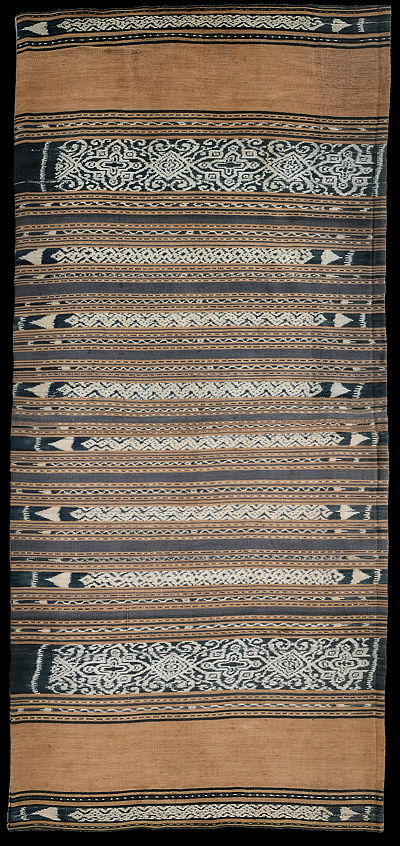| |
 
 | | | |
366 Moluccas, Babar
Roie irai (sarong)
| | Locale: | Unidentified island in the group, but, given the quality of the ikat work, most likely Babar or Marsela | | Period: | Around 1900 or before | | Yarn: | Cotton, hand-spun, fine, double-ply warp with single weft in all ikated parts, quadruple-ply warp with single weft in the plain brownish bands | | Technique: | Warp ikat | | Panels: | 2 | | Size: | 71 x 157 cm (2' 3" x 5' 1") LW: 2.21 | | Weight: | 625 g (22.0 oz), 280 g/m2 (0.92 oz/ft2) | | Design: | We see here the classic banded construction of Babar sarongs, with a narrow ikated band at the extremities followed by a wide plain band, then the widest ikated band, and a midfield consisting of numerous narrow ikated bands and stripes. This particular design was not seen on any other Babar sarongs, but as the photo referenced below (see Sources) evinces, Babar weavers were very creative and appear to have taken pride in designing their own. Of all examples known this is perhaps the most intricate. The snake motifs on nearby Tanimbar stand for courage, and are also seen as protection agains snake bites. Note that the snakes here have heads, which is not very common but also seen on the old Tanimbarese shawl PC 367. | | Comment: | Note the low specific weight, the result of the use of very fine hand-spun cotton - a hallmark of the early parts of the 20th c. and the periods before, as well as a marker of high class. Low specific weight is found in the region almost exclusively in combination with intricate design. | | Background: | Chapters on Moluccas and Babar. | | Sources: | Very similar to the sarongs shown on a photo made during the 1913-1914 Müller-Wismar expedition, published in De Jonge & Van Dijk, Forgotten Islands, p. 130, as well as in Ten Hoopen, Ikat Textiles of the Indonesian Archiipelago, p. 476. | | |

©Peter ten Hoopen, 2024
All rights reserved.
|
|


